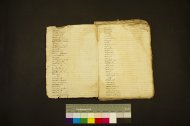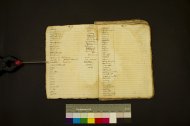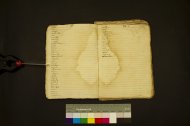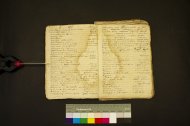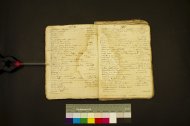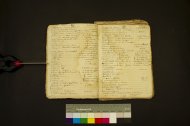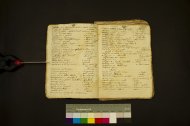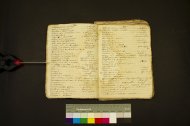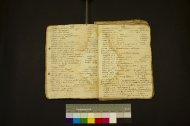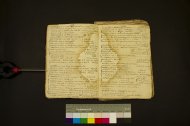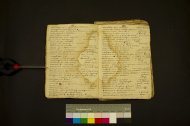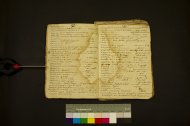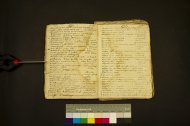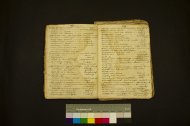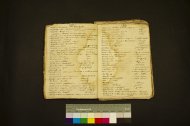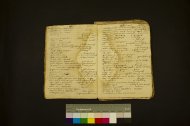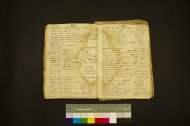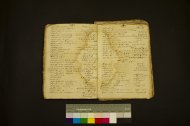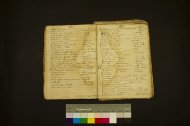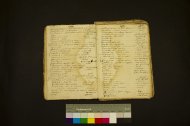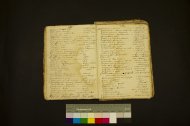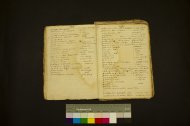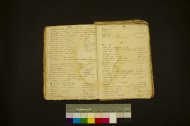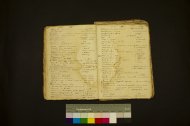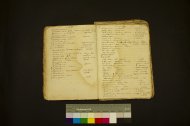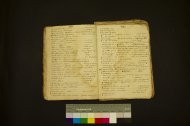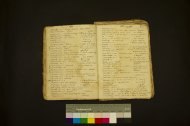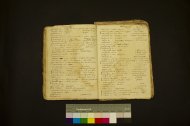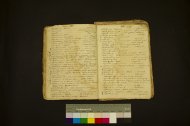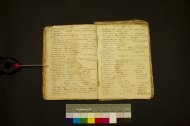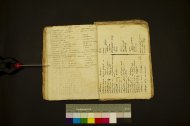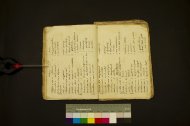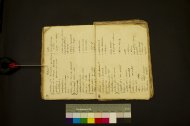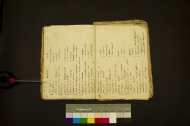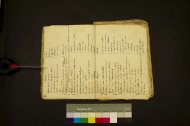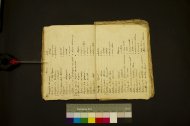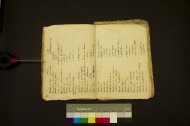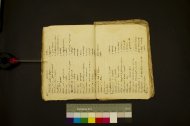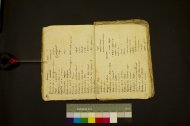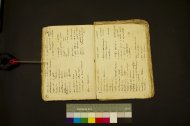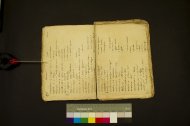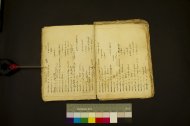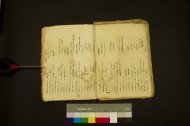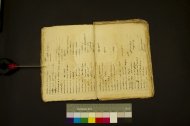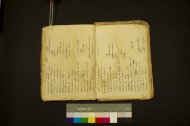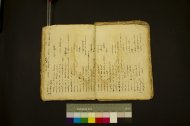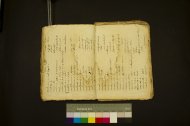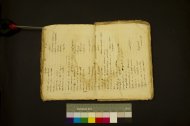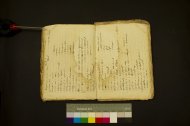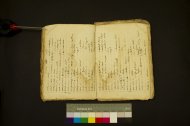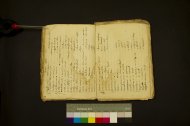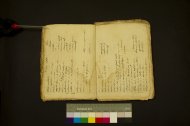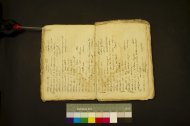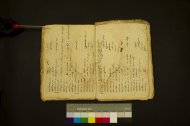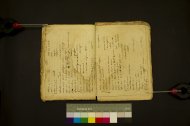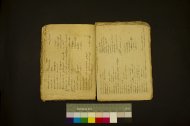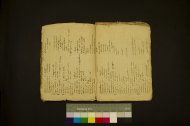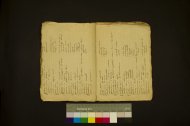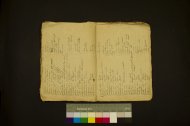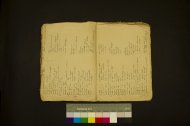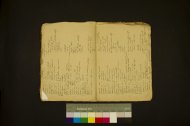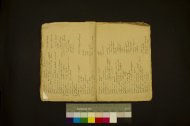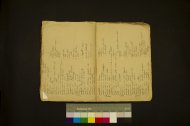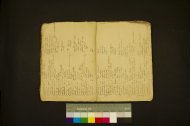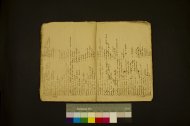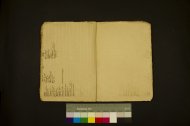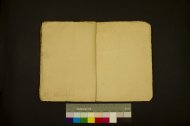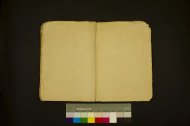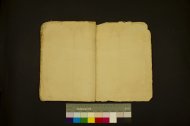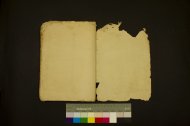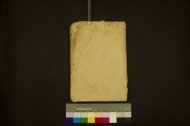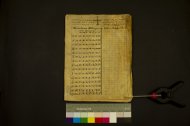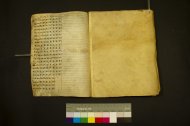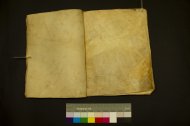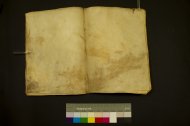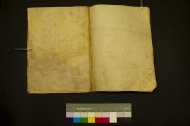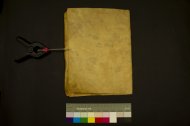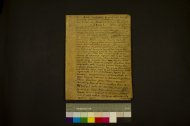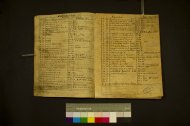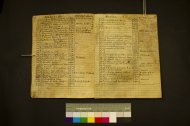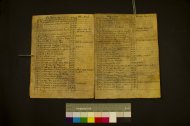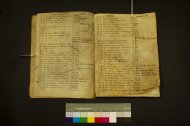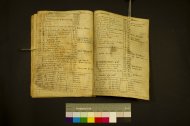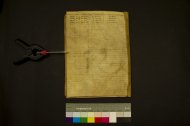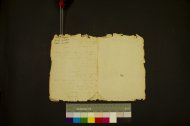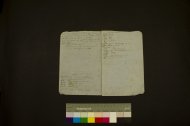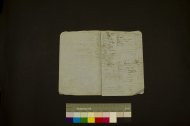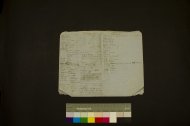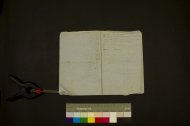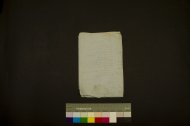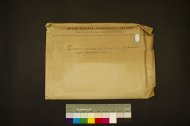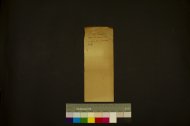The item consists of three separate units, labelled SGI 248.F, SGI 248.G, and SGI 248.H. The item also includes due additional loose quires, labelled 1 and 2. All of them came together at the Società Geografica Italiana in a large envelope, bearing the following inscription in Italian: “Tre quaderni manoscritti (F.G.H.) del P. Léon des Avanchers di soggetto rispettivamente indicato”.
SGI 248.F
|
Shelfmark |
SGI 248.F |
|
Other shelfmarks |
Zanutto 9 |
|
Owning institution |
Società Geografica Italiana, Rome |
|
Typology |
Notebook |
|
Copying date |
Ca. 1865 (see f. 1r) |
|
Title |
Latin-Amharic-Oromo-Sidamo vocabulary |
|
Subject |
Aethiopica, Lexicon |
|
Language |
Latin, Amharic, Oromo, Sidamo. |
|
Short description of the content |
Ff. 1r–75v: Latin-Amharic-Oromo vocabulary, incomplete. The vocabulary is arranged on three irregular columns. The first column accommodates an alphabetical list of Latin words. The second and the third columns accommodate the corresponding meanings in Amharic and Oromo, transcribed in Latin script. On ff. 47v–48v a fourth column has been added with a few counterparts in Sidamo. Languages are indicated on the top of the column; the Oromo wordlist is marked mostly as “Galla” (ff. 7v, 9v–10v, 13v–18r, etc.), sometimes as “Oromo” (ff. 3v, 6v–7r), and occasionally as both (ff. 8v–9r). A large number of Latin entries have no Amharic, Oromo or Sidamo counterpart. Sections are indicated on the top of the page: A (f. 1r), B (f. 6v), C (f. 8r), D (f. 17v), E (f. 21v), F (f. 24r), G (f. 28r), H (f. 30r), I (f. 32r), L (f. 42v), M (f. 47v), N (f. 56v), O (f. 61r), P (f. 66r). The vocabulary is incomplete: it stops abruptly on f. 75v with the word “procurro – curri”. The year of composition of the lexicon has been added in the upper inner corner of f. 1: “1865”. The reading is uncertain due to ink partially faded out. |
|
Writing material |
Paper |
|
Outer size of the textblock |
253 x 178 x 18 mm |
|
Number of folia |
80 |
|
Blank folia |
Ff. 76r–80v |
|
Binding |
The quire is unbound. |
|
Sewing |
Two Z-twisted threads of vegetal origin. |
|
Sewing pattern |
– |
|
Slip case (maḫdär) |
– |
|
Quires |
4 |
|
Quire marks |
– |
|
Layout |
1/2 column(s) of irregular size. |
|
Number of lines per column |
Ff. 1r–38v: 31–33; Ff. 39r–75v: 15–23. |
|
Ruling |
The manuscript is unruled. |
|
Ruling pattern |
– |
|
Scribe |
Léon des Avanchers |
|
Rubrication |
– |
|
Colophon |
– |
|
Additional notes |
–
|
|
Decoration |
– |
|
State of preservation of the textblock |
Mediocre. Material damages are mainly located at the beginning and at the end of the manuscript: f. 1 shows a large fold in the upper right corner, and f. 80 has gaps of different sizes. The rest of the textblock is characterized by various folds, small tears, holes, and extensive stains due to humidity, especially at the center of all leaves. There are also consistent and inconsistent deposits on all leaves. |
|
Provenance and history |
The manuscript was compiled by Father Léon des Avanchers in 1865. Léon des Avanchers was involved in the SGI expedition (also known as the Antinori Expedition, 1876–1882) for his knowledge of the region. Des Avanchers was imprisoned by Queen Genne Gummiti, together with the engineer and geologist Giovanni Chiarini and Antonio Cecchi, navy captain. Only Cecchi survived. Des Avanchers died in captivity on 2 August 1879 in Geeraa (in Käfa), possibly poisoned (Cecchi A., 1886, Da Zeila alle frontiere del Caffa: Viaggi di Antonio Cecchi, II, 415–30). On the verge of death Léon des Avanchers donated his books to Antonio Cecchi. Cecchi was finally freed in August 1880 through the intercession of Nǝgus Täklä Haymanot and returned to Italy in January 1882. It is possible that Des Avanchers’ materials reached the Società Geografica Italiana with the return of the expedition survivors in 1882. The third volume of Cecchi’s work Da Zeila alle frontiere del Caffa: Viaggi di Antonio Cecchi, vol. III (1887) contains linguistic notes by Léon des Avanchers and Chiarini, taken from these manuscripts and edited by Ettore Viterbo |
SGI 248.G
|
Shelfmark |
SGI 248.G |
|
Other shelfmarks |
Zanutto 10 |
|
Owning institution |
Società Geografica Italiana, Rome |
|
Typology |
Quire |
|
Copying date |
19th century, dated on a paleographical basis. |
|
Title |
Ethiopic syllabary |
|
Subject |
Aethiopica, Language |
|
Language |
Gǝʿǝz, Latin |
|
Short description of the content |
Ff. 1ra–1va: Alfabeticum Aethiopicum Ghéz et Amahara (“Gǝʿǝz and Amharic Ethiopic alphabet”). Above the title is a cross with equal arms and the following Gǝʿǝz formula, in fidäl and Latin transliteration: በስመ፡ አብ፡ ወወልድ፡ ወመንፈስ፡ ቅዱስ፡ አሐዲ፡ አምላክ፡ አሜን። Besma Ab ou Wold ou Manfas Kedus ahadu Amelak. Amen. The syllabary consists of a nine-column table. The first column indicates the Ethiopic number of the consonant, from ፩ to ፴፯. The second column contains the name of the consonant in Latin transcription (“H, La, H, M, Ra, Sa, Sch, Ka, Ba”, …). Columns 3–9 contain the Ethiopic characters according to their vocalic order. Vocalic orders (“valor literarum”) are indicated as “a, ou, i, â, ê, e, o”. The syllabary also includes Amharic consonants and labiovelars. |
|
Writing material |
Sheep parchment |
|
Outer size of the textblock |
275 x 213 x 3 mm |
|
Number of folia |
6 |
|
Blank folia |
Ff. 2r–6v |
|
Binding |
The quire is unbound. |
|
Sewing |
Two S-twisted threads of vegetal origin. |
|
Sewing pattern |
– |
|
Quires |
1 |
|
Quire marks |
– |
|
Layout |
2 columns. |
|
Number of lines per column |
21 |
|
Ruling |
The quire is unruled. On f. 1r–v a table for accommodating the syllabary has been drawn up in pencil. The table counts 37 lines and 19 columns on f. 1r, and 47 lines and 11 columns on f. 1v. |
|
Ruling pattern |
– |
|
Scribe |
Léon des Avanchers |
|
Rubrication |
– |
|
Colophon |
– |
|
Additional notes |
– |
|
Decoration |
– |
|
State of preservation of the textblock |
Discrete. The textblock is heavily stiffened but has no mechanical damage. There are coherent and inconsistent superficial deposits. |
|
Provenance and history |
The manuscript was written by P. Léon des Avanchers most probably in the mid-1860s. On how it reached Italy, see, see “SGI 248.F: Provenance and history”. |
SGI 248.H
|
Shelfmark |
SGI 248.H |
|
Other shelfmarks |
Zanutto 7 |
|
Owning institution |
Società Geografica Italiana, Rome |
|
Typology |
Quire |
|
Copying date |
1865 (cp. f. 1r). |
|
Title |
Latin-Ethiopian Calendar |
|
Subject |
Aethiopica, Chronography |
|
Language |
Gǝʿǝz, Latin, Oromo |
|
Short description of the content |
Ff. 1r–16vb: Kara motuma samai kan barsissa barsissa christian catholica, kan F. Léon des Avanchers kitabe (“Kingdom of Paradise, that is, the Catholic Christian Doctrine, written by F. Léon des Avanchers”). The title in Oromo is followed by a long invocation to Mary in Latin. Incipit: o Maria! Magistra Apostolorum, spes prophetarum, scientia doctorum, benedicat te omnis lingua; et nomen sanctuum fili tui Jesus confiteatur ab omni carne. Domina mea, suscipe hoc opus manum mearum. Ff. 1v–7v: Calendarium latinum æthiopicum (“Latin-Ethiopian Calendar”). The calendar consists of a four-column table. The first column (“dies”) indicates the number of the day of each month, from 1 to 28, 30, or 31. The second column (“lett. Dominicalis”) indicates the weekday with letters from “A” to “g”. The third column, designated after the Latin months from “Januarius” to “December”, indicates the feasts of the year according to the Catholic calendar. The fourth column, designated after the Ethiopian months from “ታኅሣሥ Thasas” to “Hedar”, indicates the days and the feasts of the Ethiopian year corresponding to those of the other columns. In the lower margins of ff. 6v–7r and on f. 7v are tables for the calculation of the Easter day (“Calculum Paschale”) for the years 1865–1876. |
|
Writing material |
Sheep parchment |
|
Outer size of the textblock |
273 x 208 x 9 mm |
|
Number of folia |
7 |
|
Blank folia |
– |
|
Binding |
The manuscript is unbound. |
|
Sewing |
Two S-twisted threads of vegetal origin. |
|
Sewing pattern |
– |
|
Quires |
2 |
|
Quire marks |
– |
|
Layout |
F. 1r: 1 column. |
|
Number of lines per column |
ca. 34–40 |
|
Ruling |
The manuscript is unruled. |
|
Ruling pattern |
– |
|
Scribe |
Léon des Avanchers |
|
Rubrication |
– |
|
Colophon |
– |
|
Additional notes |
F. 1r: a note in Oromo has been added in the main hand next to the title. The text runs as follows: “motuma Ghéra nesali iemu iaou. Woga 1865 Kessali” (“kingdom of Garaa. During the year 1865”). The note indicates the year and the place (Kessali?) in which the manuscript was written. Ff. 6v–7r: some chronological notes have been added in ungrammatical Latin in the main hand in the lower margin of the folios. The notes refer to nefarious meteorological and social events occurred in the years 1861–1865. One of them also mentions Cardinal Guglielmo Massaja, but the text is poorly readable. The notes on f. 6v read as follows: “in 1861 fulgura tonitrus homines terruerunt, in mense junii. Cometam (sic) apparuit. Pluviam (sic) segetes nocuit. Ip. Massaia . In anno 1862 pro rege (sic) gloria domum aedificavi. In 1863 pluviam (sic) defuit, segetes perierunt”. The notes on f. 7r read as follows: “in 1864 famem (sic) regionem Gallarum vastavit. In 1865 bellum, morbus equorum, regnavit: Oromo bulla sacrificaverunt”. |
|
Decoration |
– |
|
State of preservation of the textblock |
Discrete. The textblock is heavily stiffened but has no mechanical damage. There are coherent and inconsistent superficial deposits. |
|
Provenance and history |
The manuscript was written by P. Léon des Avanchers, most probably in 1865 according to the note in Oromo on f. 1r and the chronological notes on ff. 6v–7r. On how the manuscript reached Italy, see, see “SGI 248.F: Provenance and history”. |
The item also includes two additional loose quires, labelled 1 and 2. Quire 1 is a medium-size paper bifolium. Ff. 1–2 contain a wordlist in an unidentified Ethiopian language written in black ink in Latin script, in all likelihood by Léon des Avanchers. Each entry is accompanied by the respective meaning in Italian. Ff. 3–4 are blank.
Quire 2 consists of three medium-size paper bifolia folded one inside the other without binding, for a total amount of 6 folia. The quire contains various Amharic wordlists written in fidäl on one or two columns (f. 3r–v is written on two columns). Each entry is accompanied by the respective meaning in Italian. The entire text is written in pale black ink, in all likelihood by Léon des Avanchers. All leaves are unruled. F. 1r: “Dei nomi degli animali domestici considerati nel loro mondo” (“About the names of the domestic animals considered in their world”). F. 1v: “Sterchi” (“Animal droppings”). F. 2r: “Semenze varie” (“Various seeds”). F. 3ra: “Insetti” (“Insects”); “Rettili” (“Reptiles”); F. 3rb: “Volatili” (“Birds”); Acquatici (“Aquatic animals”). F. 3va: untitled but contains words for kinship. F. 3vb: “Scimmie” (“Monkeys”). F. 4r: “Quadrupedi” (“Four-legged animals”). F. 5r: “Piante” (“Plants”). F. 6r: “Animali bovini” (“Bovine animals”). Ff. 2v, 4v, 5v, 6v are blank.



